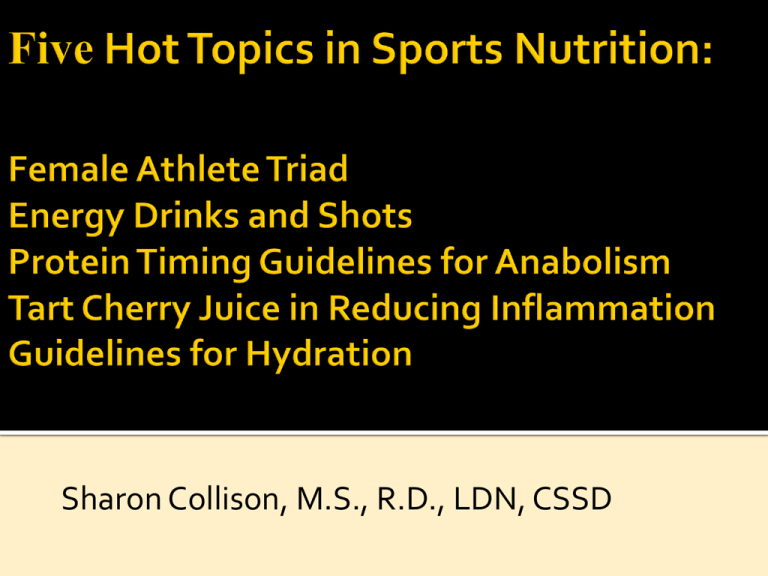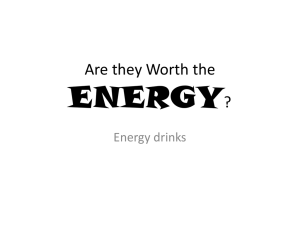
Sharon Collison, M.S., R.D., LDN, CSSD
Explain physiologic anomalies and treatment
recommendations for the female athlete triad
Discuss the high use and poor regulation of energy
drinks/shots
Discuss new dietary guidelines for protein timing
for muscle protein synthesis
Describe the role of tart cherry juice in reducing
muscle soreness and inflammation
Apply recent guidelines for adequate hydration in
athletes
Low Energy Availability
Energy availability = dietary energy intake minus the
energy expended in exercise (EA=EI-EEE)
Functional Hypothalamic Amenorrhea
(FHA)
Amenorrhea caused by low energy availability
Low Bone Mineral Density (BMD)
Z-score between -1 and -2 & secondary clinical risk
factors for fracture
Energy availability < 30 kcal/kg FFM/day results in
impaired bone formation and reproductive
function (Loucks AB et al 2011)
Increased duration of missed menstrual cycles
increases likelihood of decreased BMD (ACSM 2007)
Stress fracture risk 2-4 times greater in
amenorrheic vs. eumenorrheic athletes or BMD
below -1 (Bennell KG et al, 1999)
Increased risk of endothelial dysfunction due to
FHA
hypo-estrogenic state results in poor vasodilation
predicts long-term atherosclerotic disease progression
and CV events (Temme KE and Hoch AZ, 2013)
Implications for impaired athletic performance
(Temme KE and Hock AZ 2013)
impaired vasodilation results in decreased blood flow to
exercising muscle
decreased perfusion may limit maximal exercise
tolerance
Improved energy availability of 30-45 kcal/kg FFM
should be a priority in management of
amenorrheic athletes (ACSM 2007; Loucks et al 2011; Arends 2012) and
associated endothelial dysfunction (Temme KE and Hock AZ, 2013)
Folic acid supplementation (10 mg/day) shows
promise as a safe, effective treatment for
endothelial dysfunction in young amenorrheic
athletes (Temme KE and Hock AZ, 2013)
n, Jennifer L.; Williams, Nancy I.; De Souza,
M
Calcium: 1000-1300 mg/day
Vitamin D: 400-800 mg/day
Vitamin K 60-90 mcg/day
Folic acid supplements: 10 mg/day ??
(ACSM 2007)
(ACSM 2007)
(ACSM 2007)
(Temme KE and Hock AZ, 2013; Hock AZ 2011; Hock AZ 2010)
Further research is needed to determine lowest optimal
dose of folic acid at which significant vascular benefit
occurs
Improved BMD is more closely associated with
increased body weight than with OCP/HRT use (Nattiv et
al 2007; Ducher G et al 2011; Arends 2012)
Restoration of menses with OCP will not normalize
metabolic factors that impair bone formation,
health and performance (Ducher G et al 2011; Arends et al 2012)
Use of OCP prevents determination of a healthy
body weight as indicator of return of menses
EA = 30 - 45 kcal/kg FFM/day for weight loss
EA = 45 kcal/kg FFM for weight maintenance
EA > 45 kcal/kg FFM/day for growth and
carbohydrate loading
Strong association between increases in both
BMD & body weight implies that increasing
BMD may require EA > 45 kcal/kg FFM/day
600 energy drinks on the market
$2.5 billion dollar industry in 2009
$9 billion dollar industry in 2011
Self-report surveys show use by 30%-50% of
adolescents/young adults
Half of energy drink market consists of:
children (<12 years old)
adolescents (12–18 years old)
young adults (19–25 years old)
Fastest growing US beverage market
“Energy drinks”
marketed to improve energy, weight loss, stamina,
athletic performance, and concentration
contain caffeine (high & unregulated amounts),
guarana, taurine, vitamins, herbs, sugar/sweeteners
“Energy shots”
low-volume (1–2 oz) beverages with > concentration
of caffeine
▪ range 100–350 mg
▪ 90–171 mg per oz
8 ounces of tea (brewed):
47 mg
12 ounces Coca-Cola:
34 mg
12 ounces Sunkist:
41 mg
8 ounces Red Bull:
80 mg
8 ounces coffee:
108 mg
1.93 oz shot 5-hour energy: 242 mg
16 oz NOS energy:
260 mg
http://www.ncbi.nlm.nih.gov/pmc/articles/PMC2735818/table/T1/
tachycardia
cardiac arrhythmias
increased blood pressure
sleep disturbances, including insomnia
diuresis
vomiting
seizures
mania
stroke
sudden death
FDA limits caffeine content in soft drinks
71 mg per 12 fl oz soda; categorized as food
No FDA regulation of energy drinks
classified as dietary supplements
Safety determinations of energy drinks are made
solely by the manufacturers
No requirements for testing, warning labels, or
restriction against sales or consumption by
minors in the US
OTC caffeine stimulants (No-Doz with 100 mg
caffeine/tablet) must list
minimum age for purchase (12 years)
adverse effects and cautionary notes
recommended dose
max daily recommended dose
Yet, an energy drink with 500 mg caffeine can be
marketed with no warnings & no information on
caffeine content
Healthy adults
(Cannon et al, 2001)
≤ 400 mg/day is considered safe
acute clinical toxicity begins at 1 g
lethal dose > 5g (42 cups coffee)
Adolescent
(Heatherly et al 2006; Seifert SM et al 2011)
≤ 100 mg per day
Child
(Heatherly et al 2006; Seifert SM et al 2011)
≤ 2.5 mg/kg per day
Guarana
Contains 40 to 80 mg caffeine per gram & has a potentially longer
half-life because of interactions with other plant compounds
(Seifert et al 2011)
contains stimulants theobromine & theophylline
Taurine
addition of taurine does not improve physical and cognitive
performance better than caffeine alone (Evidence Category B)
(McLellen and Leiberman, 2012)
B vitamins
addition of multivitamins do not improve physical and cognitive
performance better than caffeine alone (Evidence Category C)
(Mclellen and Leiberman, 2012)
On Jan 2, 2013, Canada passed a law that limits
allowable caffeine in food products.
Single serving beverages limited to 180 mg
caffeine
re-sealable bottles capped at 400 mg per liter
Energy drinks (including Monster, Rockstar, 5-hr
energy and Red Bull)
reclassified as food products
forced to reformulate to comply with new rules
Labeling of energy drinks
Food
▪ Red bull
Dietary Supplement
▪ Monster
▪ 5-hr energy
These criss-crossing definitions impede
action in the US for regulation
3-6 mg caffeine/kg can significantly enhance
endurance and high-intensity performance in
trained athletes (Campbell et al 2013)
IOC mandates a limit of 12 μg/ml of urine
corresponds to 9-13 mg caffeine/kg
NCAA mandates a limit of 15 μg/ml
WADA
does not deem caffeine to be a banned substance
part of monitoring program which serves to establish
patterns of misuse in athletic competition
Ergogenic value of energy drinks is due to caffeine
and carbohydrate (Campbell B et al 2013)
3-6 mg/kg caffeine is effective and safe (Goldstein et al 2010;
Campbell 2013)
Safety and efficacy of other ingredients has not
been proven (McLellen and Leiberman, 2012)
Athletes need to consider that energy drinks are
not regulated and can be potentially harmful
Education regarding risk/benefit of energy drinks
in athletes is warranted
Endurance athletes
▪ 1.2-1.4 g/kg body weight
▪ Accounts for use of protein as fuel for
energy
Strength athletes
▪ 1.2-1.7 g/kg body weight
▪ Supports muscle growth, especially during
early training phase
Protein supplementation pre- and post-workout
increases lean body mass, muscle hypertrophy,
and strength and recovery
Immediate intake is recommended since exercisemediated increases in muscle protein synthesis
rate (MPS) are greatest immediately after exercise
Essential amino acids (EAAs) stimulate increased
rates of MPS
20-25 g whey protein isolate considered to be
superior to other proteins in stimulating MPS (Poortmans
JR et al 2012; Tipton et al 2011; Moore DR et al 2012; Beelen M et al 2010; Hulmi et al 2010; Stark 2012; ChurchwardVenne TA et al 2012)
readily digestible immediately after exercise training
rapidly absorbed by the intestinal tract
contains 8–10 g EAAs
contains a high BCAA content, primarily leucine
unique role in initiating protein translation
leucine content of protein source impacts protein
synthesis and affects muscle hypertrophy (3 g)
Dairy-soy blend (whey + casein + soy) has also been
found to be an effective post-exercise supplement
(Reidy PT et al 2013)
Sufficient EAA content
Several digestion rates
Prolonged aminoacidemia
Fat-free milk post-workout also effective in
promoting increases in lean body mass, strength,
muscle hypertrophy and decreases in body fat
(Stark et al 2012)
.
.
20 year old offensive lineman
Height = 6’4”
Weight = 321#
Breakfast: 2 poptarts, 16 oz gatorade
Lunch: 2 pb/j sandwiches, 16 oz apple juice
Dinner: 12 oz chicken, 1 cup mashed potatoes, 1
roll, 2 cups 2% milk
Snack: 1 slice pizza
120
100
80
60
40
20
0
breakfast
lunch
pre-workout post-workout
dinner
bed snack
Breakfast: 2 poptarts, 16 oz gatorade
Add 2 eggs, 2 slices turkey bacon, whole grain English muffin and 1 orange
Lunch: 2 pb/j sandwiches, 16 oz apple juice
Change to 4 oz turkey sandwich with 1 oz sun chips and 1 apple
Preworkout: Add protein/carb bar
Postworkout: Add whey protein shake with 20 grams protein plus peanut butter
and jelly sandwich
Dinner: 12 oz chicken, 1 cup mashed potatoes, 1 roll, 2 cups 2% milk
Reduce to 5 oz chicken and 1 cup milk; add 1 cup broccoli
Before bed: 1 slice pizza
Change to 2 packets oatmeal made with milk plus ¼ cup nuts
50
45
40
35
30
25
20
15
10
5
0
breakfast
lunch
pre-workout
post-workout
dinner
bed snack
Quantity: 1.4 - 2 g/kg body weight/day
Quality: whey, cow’s milk or protein blend are best
Timing: 20-30 grams at each meal plus after
workout/snacks to meet needs
Additional protein (milk or casein) 30 minutes
before bed (Res et al 2012)
Addition of carbohydrate prior to and following
exercise (1.2-1.5 g/kg) (Kerksick C et al 2008)
Kcal intake of 44-50 kcal/kg body weight (Stark M et al 2012:
JADA 2000)
RICE
NSAIDs
NSAIDs are most used and prescribed
medication in US (Kuehl 2013)
Adverse side effects
▪ gastric ulceration
▪ MI and stroke are also possible
▪ efficacy for their use in alleviating inflammatory symptoms
remains questionable
▪ attenuates adaptive processes in exercise training and
therefore should not be used long term (Glyn H and van Someren KA 2008)
Anti-inflammatory foods can mediate
inflammatory process with fewer side effects
Tart cherry juice contains high levels of
antioxidant/anti-inflammatory compounds (Wang H et al
1999; Connolly DA et al 2006; Bowtell JL et al 2011)
Cyclo-oxygenase inhibitory flavonoids
Anthocynanins
Tart cherry consumption appears to be effective in
treating acute inflammation & injury pain among
athletes (Kuehl 2013)
Interleuken-6 (IL-6) 49% lower in tart cherry juice
group
C-reactive protein (CRP) 34% lower in tart cherry
juice group
Uric acid levels were unchanged in tart cherry
juice group but elevated in the placebo group
Results have important practical significance for
distance runners since the inflammatory
response to prolonged endurance exercise
(particularly IL-6) has been linked to delayed
recovery
Scandinavian Journal of Medicine & Science in Sports
Volume 20, Issue 6, pages 843-852, 21 OCT 2009 DOI: 10.1111/j.1600-0838.2009.01005.x
http://onlinelibrary.wiley.com/doi/10.1111/j.1600-0838.2009.01005.x/full#f1
Subjective report of pain after eccentric
exercise with cherry juice vs. placebo
Connolly D A J et al. Br J Sports Med 2006;40:679-683
Copyright © BMJ Publishing Group Ltd & British Association of Sport and Exercise Medicine. All rights reserved.
Reduced muscle damage (Bowtell et al 2011; Connolly et al 2006)
Reduced pain perception (Kuehl et al 2010)
Recovery of strength (Howatson et al 2009; Connolly et al 2006)
Reduced inflammation (Howatson et al 2009)
Reduced oxidative stress (Bowtell et al 2011; Howatson G et al 2009;
Traustadottir R et al 2009)
NFL
DALLAS COWBOYS
NEW ENGLAND PATRIOTS
PITTSBURGH STEELERS
SEATTLE SEAHAWKS
KANSAS CITY CHIEFS
NEW YORK GIANTS
SAN DIEGO CHARGERS
ST LOUIS RAMS
MLB
COLORADO ROCKIES
PHILADELPHIA PHILLIES
NEW YORK METS
SEATTLE MARINERS
NHL
CHICAGO BLACKHAWKS
FLORIDA PANTHERS
EDMONTON OILERS
NEW YORK RANGERS
NBA
HOUSTON ROCKETS
NEW YORK KNICKS
Before exercise: > 4 hrs before exercise, drink 5-7
ml/kg body weight of water or sport beverage
During exercise: drink to avert a water deficit in
excess of 2% body weight
Amount and rate is dependent on an individual athletes
sweat rate, exercise duration and opportunities to drink
Individualized hydration protocols are indicated
After exercise: drink at least 16-24 oz of fluid per
pound of body weight lost during exercise
Consuming rehydration beverages and salty foods at
meals/snacks will help replace fluid/electrolyte losses
Recommendations to limit dehydration to </=2%
body weight during exercise is based on results of
studies that used exercise protocols where athletes
exercise at fixed-work rates until exhaustion
Results derived from fixed-intensity exercise
models cannot be assumed to apply to the more
realistic setting of self-paced competition
Field research shows that athletes can achieve
outstanding endurance performance while
dehydrated
2% body weight loss rule does not apply to realworld exercise events
Only under exercise conditions comprising fixedpower output work does exercise induced
dehydration impair endurance performance
Exercise-induced dehydration up to 4% BW does
not impair endurance performance during realworld exercise conditions
Endurance athletes are encouraged to follow thirst
cues during exercise
Individualized, realistic, and evidence-based fluid
replacement recommendations are needed based
on each athlete (Lopez RM et al 2011)
Pay attention to thirst sensation by drinking fluids
ad libitum
2 hr before exercise, ensure euhydration by
drinking enough fluid
about 5–10 ml/kg body weight
produce 2 micturitions that are very pale yellow
to pale yellow in color
Indicates body weight is within 1% of wellhydrated baseline body weight
1
2
3
4
5
USE URINE COLOR AS A GUIDE
If your urine matches the colors 1, 2,
or 3, you are properly
hydrated. Continue to consume fluids
at the recommended
amounts.
If your urine color is below the BLUE
line, you are DEHYDRATED and at
risk for cramping / a heat illness!
6
7
8
YOU NEED TO DRINK MORE
WATER / SPORTS DRINK!
Endurance performance is maximized when
plasma osmolality is regulated during
exercise rather than body weight
Drinking to satisfy thirst during exercise
should preserve extracellular fluid
homeostasis and maximize endurance
performance
Fluid intake is not important for maximization of
endurance performance < 1 hour
Trying to fully replace fluid losses during highintensity exercise may lead to gastrointestinal
problems, which may impede performance
To optimize performance, mouth-rinse
approximately every 8–10 min for 5–10 s with
approximately 20–25 ml of a 6% sports drink
solution.
Research field is limited and much remains to be
learned before reliable recommendations can be
confidently made to competitive endurance
athletes seeking the best performance (Goulet ED 2012)
Need for future studies looking at the relationship
between endurance performance and dehydration
Include control group drinking to thirst
use research designs simulating out-of-doors exercise
conditions as best as possible






